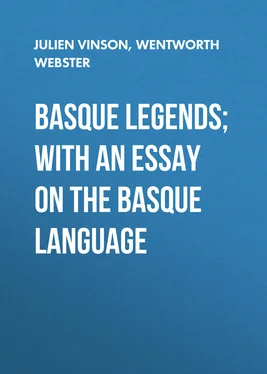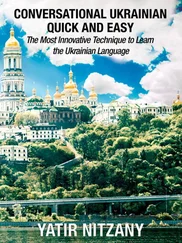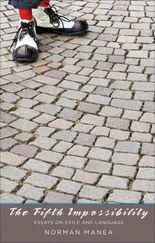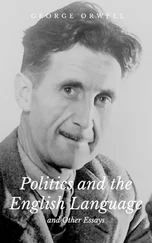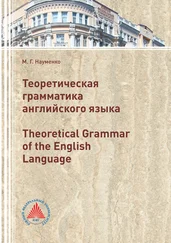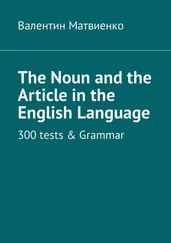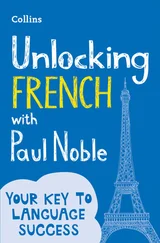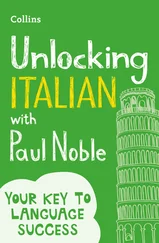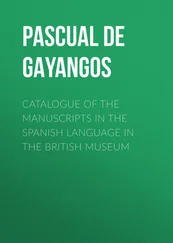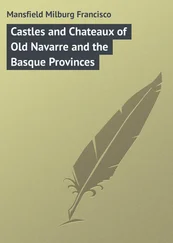Julien Vinson - Basque Legends; With an Essay on the Basque Language
Здесь есть возможность читать онлайн «Julien Vinson - Basque Legends; With an Essay on the Basque Language» — ознакомительный отрывок электронной книги совершенно бесплатно, а после прочтения отрывка купить полную версию. В некоторых случаях можно слушать аудио, скачать через торрент в формате fb2 и присутствует краткое содержание. Жанр: foreign_antique, Старинная литература, Мифы. Легенды. Эпос, на английском языке. Описание произведения, (предисловие) а так же отзывы посетителей доступны на портале библиотеки ЛибКат.
- Название:Basque Legends; With an Essay on the Basque Language
- Автор:
- Жанр:
- Год:неизвестен
- ISBN:нет данных
- Рейтинг книги:3 / 5. Голосов: 1
-
Избранное:Добавить в избранное
- Отзывы:
-
Ваша оценка:
- 60
- 1
- 2
- 3
- 4
- 5
Basque Legends; With an Essay on the Basque Language: краткое содержание, описание и аннотация
Предлагаем к чтению аннотацию, описание, краткое содержание или предисловие (зависит от того, что написал сам автор книги «Basque Legends; With an Essay on the Basque Language»). Если вы не нашли необходимую информацию о книге — напишите в комментариях, мы постараемся отыскать её.
Basque Legends; With an Essay on the Basque Language — читать онлайн ознакомительный отрывок
Ниже представлен текст книги, разбитый по страницам. Система сохранения места последней прочитанной страницы, позволяет с удобством читать онлайн бесплатно книгу «Basque Legends; With an Essay on the Basque Language», без необходимости каждый раз заново искать на чём Вы остановились. Поставьте закладку, и сможете в любой момент перейти на страницу, на которой закончили чтение.
Интервал:
Закладка:
Wentworth Webster
Basque Legends; With an Essay on the Basque Language
Introduction
The study of the recent science of Comparative Mythology is one of the most popular and attractive of minor scientific pursuits. It deals with a subject-matter which has interested most of us at one period of our lives, and turns the delight of our childhood into a charm and recreation for maturer age. Nor is it without more useful lessons. In it we see more clearly than perhaps elsewhere the reciprocal influence, which none can wholly escape, of words and language upon thought, and again of thought and fancy upon words and language; how mere words and syllables may modify both conception and belief; how the metaphor, which at first presented an object more clearly and vividly to the mind than any more direct form of speech could do, soon confuses and at last wholly distorts the original idea, and buries its meaning under a new and foreign superstructure. We may mark here, too, by numerous examples, how slowly the human mind rises to the conception of any abstract truth, and how continually it falls back upon the concrete fact which it is compelled to picture to itself in order to state in words the simplest mental abstraction. The phrase, “The dawn flies before the sun,” passing into the myth of Daphne and Apollo, is a lesson in psychology no less than in philology and in comparative mythology.
Now, both the interest and the value of these studies are enhanced in proportion as they become complete. Our conclusions approach nearer to certainty, and will gradually pass from theory to demonstration, as we find the same legends and modes of thought and expression on natural phenomena constantly reappearing among the most distant and the most isolated peoples, in languages which in their complex forms tell of the infancy of human speech, and also in those whose worn-down frame speaks of the world’s old age.
Of the peoples now settled in Western Europe, the Basques are those which are the most separate from other populations; distinct in language, they represent, in a more or less mixed state, some older stratum of European ethnology. Their language, too, as regards the mass of the people, is still practically unwritten. 1 1 See on this head M. Vinson’s Essay in Appendix.
Here there is a chance of finding legends in a purer and older form than among any other European people; and in what they have borrowed from others, we may have an almost unique crucial test of the time which it takes for such traditions to pass orally from people of one language to another and totally different one. None of these legends have been published or even noticed till within the last two years, when M. d’Abbadie read the legend of the Tartaro before the Société des Sciences et des Arts de Bayonne, and M. Cerquand his “Légendes et Récits Populaires du Pays Basque,” before the sister society at Pau. 2 2 The second part of M. Cerquand’s “Légendes et Récits Populaires du Pays Basque” (Pau, 1876), appeared while the present work was passing through the press. It is chiefly occupied with legends of Basa-Jaun and Lamiñak.
Of course we must expect to find such legends very much altered, and in a state of almost inextricable confusion, and this not only through forgetfulness, and through the lapse of time since their origin, not only by the influence of a total change of religion, but they are also mingled and inter-penetrated with totally new ideas; the old and the new will be found side by side in striking and sometimes grotesque contrast. As in Campbell’s “Tales of the West Highlands,” personages of mythical antiquity go to kirk, and indulge in other decidedly post-Reformation practices, so in these Basque tales the reader must not be startled by the introduction of maize and tobacco, of cannon and gunpowder, of dances at the mairie, and the use of the guillotine, in stories which, perhaps, originally told of the movements of the stars, of the wars of the forces of the atmosphere, of the bright beauty of the rising, or of the glowing glory of the setting sun. 3 3 Not that we suppose all these tales to be atmospheric myths; we adopt this only as the provisional hypothesis which appears at present to cover the largest amount of facts. It seems certainly to be a “vera causa” in some cases; but still it is only one of several possible “veræ causæ,” and is not to be applied to all.
The body is the same in all ages, but the dress varies with the changing fashions. To borrow an illustration from a slightly older science, this is not a simple case of contorted and overlying strata to be restored to their original order, but rather of strata worn down, reconstructed, and deposited anew, and even modified in their latest stage by the interference of human action. And thus our problem becomes an exceedingly complex and difficult one, and our readers must not be disappointed if our conclusions are not so clear and positive as might be wished. The present is merely a tentative, and not, in any sense, a final essay towards its solution.
How are these legends told now, and how have they been preserved? They are told by the Basque peasants, either when neighbours meet—after the fashion made familiar to us by American novelists in the “Husking Bee”—for the purpose of stripping the husks from the ears of maize, an operation generally performed in one or two long sessions; or at the prolonged wedding and other feasts, of which we have evidence in the tales themselves, or else in the long nights round the wintry hearth of their lonely dwellings. For it is one of the charms of the Basque land that the houses are scattered all over the face of the country, instead of being collected into crowded villages; and it is, perhaps, to this fact chiefly that we owe the preservation of so much old-world lore, and of primitive ideas, among this people. The reader must not be surprised at the length of some of our specimens. The details of the incidents of the longest are religiously preserved and, as told at home, they are probably more lengthy (as anyone will understand who has ever taken anything down from recitation) than as here given. Many an unlettered Basque peasant could serve an irritable stranger as Glendower did Hotspur, when he kept him “at least nine hours in reckoning up the several devils’ names that were his lackeys.”
In La Soule the “Pastorales,” or Basque dramas, which last from six to eight hours of uninterrupted action, are learnt in the same way by word of mouth during the long evenings of winter.
These legends are still most thoroughly believed in. They still form part of the faith of these simple people—not at all, we need hardly say, in the use of mythological or atmospheric allegory, but as narratives of veritable fact. They believe them as they do the histories of the Bible or the “Lives of the Saints.” In fact, the problem of reconciling religion and science presents itself to their minds in this strange guise—how to reconcile these narratives with those of the Bible and of the Church. The general solution is that they happened before the time of which the Bible speaks, or before Adam fell. They are “Lege zaharreko istorriguak”—“histories of the ancient law”—by which is apparently meant the time before Christianity. “This happened, sir, in the time when all animals and all things could speak,” was said again and again by our narrators at the commencement of their story; not one doubted the literal truth of what they told. Their naïve good faith occasionally severely tested our own gravity. Appeal was often made to our supposed superior knowledge to confirm the facts. The varying tone of the voice told how truly the speakers sympathised with what they uttered. At times sobs almost interrupted utterance, when the frequent apostrophe came: “Think how this poor so-and-so must have suffered!” More often bursts of laughter at traditional jokes, too poor to raise a smile on less unsophisticated lips, broke the recital. Very determined, too, is their adherence to what they believe to be the genuine text of these old tales. “I don’t understand it, but the history says so;” “It is so;” “The story says so,” was positively affirmed again and again—e.g., in one of the Peau d’Ane or Cinderella stories, when the lady has dazzled her admirer by her dress of silver (moonlight?), then of gold (sunlight?), then of diamonds (dew-drops?), at last, on the wedding-day, the bride and bridegroom dress each other. “I don’t know why,” interrupted the story-teller, “but the story says so.” Could anything tell more quaintly of the marriage of the sun and dawn? The sun decking the morning clouds with his light and beauty, and they again robing him in their soft and tender colouring.
Читать дальшеИнтервал:
Закладка:
Похожие книги на «Basque Legends; With an Essay on the Basque Language»
Представляем Вашему вниманию похожие книги на «Basque Legends; With an Essay on the Basque Language» списком для выбора. Мы отобрали схожую по названию и смыслу литературу в надежде предоставить читателям больше вариантов отыскать новые, интересные, ещё непрочитанные произведения.
Обсуждение, отзывы о книге «Basque Legends; With an Essay on the Basque Language» и просто собственные мнения читателей. Оставьте ваши комментарии, напишите, что Вы думаете о произведении, его смысле или главных героях. Укажите что конкретно понравилось, а что нет, и почему Вы так считаете.
